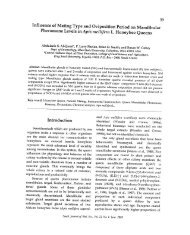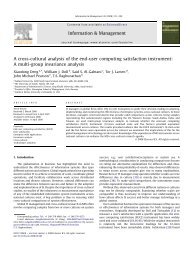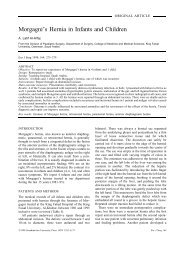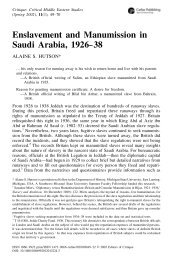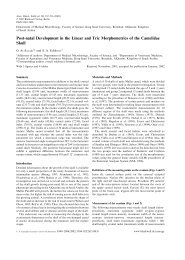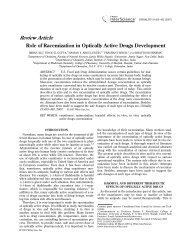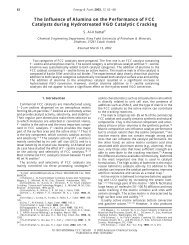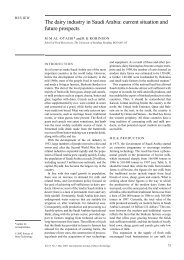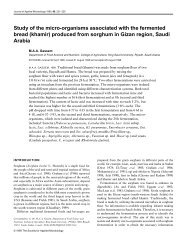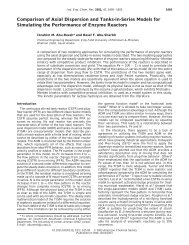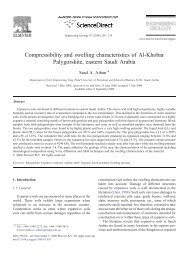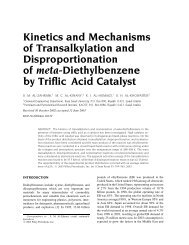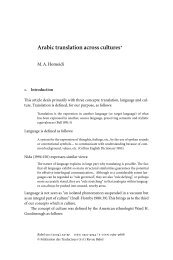Khat (Catha edulis)—an updated review
Khat (Catha edulis)—an updated review
Khat (Catha edulis)—an updated review
You also want an ePaper? Increase the reach of your titles
YUMPU automatically turns print PDFs into web optimized ePapers that Google loves.
Addiction Biology (December 2005) 10, 299 – 307<br />
REVIEW<br />
<strong>Khat</strong> (<strong>Catha</strong> <strong>edulis</strong>)<strong>—an</strong> <strong>updated</strong> <strong>review</strong><br />
NEZAR N. AL-HEBSHI & NILS SKAUG<br />
Department of Oral Sciences—Oral Microbiology, Faculty of Dentistry, University of Bergen, Norway<br />
Abstract<br />
The habit of chewing fresh leaves and twigs of khat (<strong>Catha</strong> <strong>edulis</strong>) for their stimulating amphetaminelike<br />
effects is highly prevalent in East Africa and southwest on the Arabic peninsula. There is an<br />
extensive literature on khat providing information about its history, botany, production, geographical<br />
distribution, chemistry and pharmacology, and exploring the social, economic, medical, psychological<br />
and oral aspects related to its use. Some of this literature dates as early as the 11th century; however,<br />
most of it appeared after the first scientific description of khat by Peter Forskal in 1775. This <strong>review</strong><br />
provides a panorama of khat and the various aspects of its use. A non-technical description of the plant<br />
chemistry and pharmacology is included. The medical, psychological and oral aspects are emphasized,<br />
and the current knowledge about the microbiological effects of khat is also presented.<br />
<strong>Khat</strong> at a glance<strong>—an</strong> introduction<br />
<strong>Khat</strong> is the name generally used for <strong>Catha</strong> <strong>edulis</strong>, a<br />
dicotyledonous evergreen shrub of the family Celastraceae<br />
(Kennedy, 1987a) [also spelled qat, kat, cat or ghat; The<br />
Amharas call it ‘tchat’ and the Gallas ‘Jimma’; in Kenya khat is<br />
known as ‘miraa’; Qat is probably the most correct transliteration<br />
of the Arabic word ]. The first scientific description<br />
of khat as <strong>Catha</strong> <strong>edulis</strong> was in Flora-Aegyptiaco-Arabia by the<br />
Swedish botanist Peter Forskal, who died in Arabia in 1768<br />
(Peters, 1952). Most published work refers to khat as the only<br />
representative of the genus <strong>Catha</strong> (Paris & Moyse, 1958;<br />
Nordal, 1980); however, Revri (1983) showed that the genus<br />
contains another member, <strong>Catha</strong> spinosa, which is found only<br />
in Yemen where it exists in the wild state and at lower<br />
elevations. The khat tree has a slender bole and white bark<br />
(Getahun & Krikorian, 1973). In Yemen, the trees range from<br />
1 to 10 m in height, while in Ethiopian highlands they can<br />
reach heights of 18 m; however, they are pruned annually to<br />
keep their height to about 5 m (Peters, 1952). <strong>Khat</strong> cultivars<br />
show considerable variations in their general appearance, due<br />
probably to cultivation of the plant over centuries under<br />
different ecological conditions (Nordal, 1980). A detailed<br />
botanical description of the macroscopic and microscopic<br />
features of khat leaves, flowers, seeds and fruits is given by<br />
Paris & Moyse (1958), Nordal (1980) and Revri (1983).<br />
The major cultivation and production areas of khat are in<br />
Ethiopia, particularly in Harar district, and in Yemen (Brooke,<br />
1960). It is also cultivated, to a lesser extent, on the slopes<br />
of Mount Kenya and grows wild in many mountainous parts<br />
of eastern Africa including South Africa, Uganda, Tanzania,<br />
Rwanda and Zimbabwe (Peters, 1952; Brooke, 1960) (some of<br />
these countries are referred to by their older names in the<br />
original reports). There are sporadic reports of khat-growing in<br />
Turkistan, Afghanistan and northern Hejaz (Brooke, 1960).<br />
<strong>Khat</strong> grows at an altitude of 1670 – 2590 metres (5500 – 8500<br />
feet) adapting to a range of soil and climatic conditions. It is<br />
cultivated on terraces built on hillsides where the trees grow in<br />
rows interspersed occasionally with other crops (Peters, 1952;<br />
Brooke, 1960; Getahun and Krikorian, 1973).The khat tree is<br />
rarely affected by diseases and can live up to 75 – 100 years if<br />
taken care of properly (Peters, 1952; Brooke, 1960; Kennedy,<br />
1987a).<br />
<strong>Khat</strong> is a high-cash income crop. It is profitable to the huge<br />
number of people involved in its production and marketing<br />
including farmers, distributors and merchants. Taxes upon it<br />
are an important source of revenue to the governments as well<br />
(Getahun & Krikorian, 1973; Kennedy, 1987b; Lemessa,<br />
2001). In Ethiopia, 85 – 90% of the khat produced is exported<br />
(Lemessa, 2001) and thus makes a very significant contribution<br />
to the country’s foreign exchange earnings. In 1999/2000,<br />
khat worth $55 million was exported to different countries,<br />
ranking second in export revenues (Lemessa, 2001). In<br />
Yemen, estimates in the early 1980s, i.e. before oil production<br />
commenced, attributed 30% of the gross domestic product<br />
(GDP) to khat (Kennedy, 1987b). However, as Yemeni khat<br />
is not exported, its macroeconomic significance is not<br />
pronounced as the case is in Ethiopia. At the family level,<br />
khat may be damaging to budgets, especially among the poor.<br />
Correspondence to: Nezar Noor Al-Hebshi, Laboratory of Oral Microbiology, Armauer Hansens Hus, N-5021, Bergen, Norway.<br />
Tel: +47 55975784; Fax: +47 55974979; E-mail: Nezar.Al-hebshi@student.uib.no<br />
ISSN 1355-6215 print/ISSN 1369-1600 online/05/040299–09<br />
ª Society for the Study of Addiction to Alcohol and Other Drugs Taylor & Francis<br />
DOI: 10.1080/13556210500353020
300 N. N. Al-Hebshi & N. Skaug<br />
In the late 1980s Kennedy (1987b) estimated that 10% of the<br />
Yemeni population suffered economic hardship due to khat<br />
use; the figure must have increased by now due to economic<br />
deterioration since the early 1990s.<br />
There is much speculation about the early history of khat. A<br />
theory by Cotterville-Girandet (cited in Kennedy, 1987c)<br />
suggests that khat was known to the ancient Egyptians, while<br />
more factual Arabic sources indicate that it was known as a<br />
medicinal plant as early as the beginning of the 11th century in<br />
Turkistan and Afghanistan (Kennedy, 1987c). The most<br />
debated historical issue about khat is whether it originated in<br />
Yemen and then spread to Ethiopia, or vice versa. The earliest<br />
mention of khat in this region is in the chronicle of the Ethiopian<br />
king Amda Seyon (1314 – 1344). Accordingly, most writers<br />
believe khat to be of Ethiopian origin (Getahun & Krikorian,<br />
1973). In line with that, Sir Richard Burton, in his First Footsteps<br />
in East Africa, first published in 1856, describes how khat was<br />
introduced to Yemen from Abyssinia (Ethiopia) in the 15th<br />
century (Burton, 1966). However, there is some evidence that<br />
khat was introduced to Yemen as early as the 13th century<br />
(Kennedy, 1987c). The opposite view, that khat is of Yemeni<br />
origin, is supported by some Ethiopian legends that were<br />
recounted by Gethahun & Krikorian (1973). Based on<br />
cytogenetic (hereditary) botanical analysis, Revri (1983) also<br />
supports this view. For a comprehensive and attractive account<br />
on the history of khat, refer to Kennedy’s The flower of paradise:<br />
the institutionalized use of the drug qat in North Yemen (Kennedy,<br />
1987c).<br />
Chemistry<br />
Duringtheperiodfrom1887to1978,therewasalongseries<br />
of chemical studies focusing on the identification of khat’s<br />
active principle and the characterization of its alkaloid content.<br />
Early attempts attributed the stimulating effects of khat to<br />
cathine, a phenylalkaylamine-type constituent characterized as<br />
(þ)-norpseudoephedrine. However, later work provided initial<br />
evidence for the presence of another more active phenylalkylamine<br />
in the fresh leaves of the plant, possibly a labile<br />
precursor of cathine. In 1975, the long-sought phenylalkylamine<br />
was finally isolated, characterized as (7)-a-aminopropiophenone<br />
and given the name (7)-cathinone (Anonymous, 1975).<br />
Later studies showed that cathinone is present at a high<br />
concentration in the young leaves, while being converted rapidly<br />
in the adult leaves into cathine and, to a lesser extent, into<br />
norephedrine: another phenylalkylamine described in khat.<br />
Both cathine and cathinone are related structurally to amphetamine<br />
(Zelger et al., 1980) (see Fig. 1). The <strong>review</strong>s by<br />
Szendrei (1980), Kalix & Braenden (1985) and Kennedy<br />
(1987a) provide a comprehensive description of the progress<br />
in the understanding of khat chemistry during that period.<br />
Figure 1. Chemical structures of amphetamine, cathine and cathinone.<br />
In parallel, studies also resulted in the characterization of a<br />
complex group of alkaloids called cathedulins (Anonymous,<br />
1977a; Baxter et al., 1979). Recently, analysis using liquid<br />
chromatography/mass spectrometry revealed the presence of<br />
62 cathedulin alkaloids in the crude methanolic extracts of<br />
fresh khat (Kite et al., 2003), supporting earlier beliefs that<br />
<strong>Catha</strong> <strong>edulis</strong> may well be one of the plant species showing the<br />
most complicated pattern of alkaloid composition (Anonymous,<br />
1977b). Many other chemical constituents were<br />
identified in khat. Tannins were found to be present in<br />
considerable quantities that vary among different cultivars<br />
(7 – 14%) (Halbach, 1972). Another constituent also found to<br />
be present in significant amounts is vitamin C. Mustard<br />
(1952) measured it to be 136 mg/100 g of the leaves and<br />
branch tips, and 325 mg/100 g of the leaves only. Other<br />
ingredients described in khat include a- and b-sitosterol and<br />
friedeline (Anonymous, 1977b), triterpenoids (Crombie,<br />
1980), essential oils and amino acids (Szendrei, 1980),<br />
proteins, carotene, calcium, thiamine, riboflavin, niacin and<br />
iron (Getahun & Krikorian, 1973).<br />
Pharmacology<br />
The pharmacologically active constituents of khat are (7)cathinone<br />
and, to a lesser extent, (þ)-norpseudoephedrine.<br />
Maximal plasma concentrations of (7)-cathinone, after a<br />
single oral dose of khat, are attained in about 2 hours;<br />
the terminal elimination half-life is about 4 hours (Widler<br />
et al., 1994). The major metabolite of (7)-cathinone is<br />
(7)-norephedrine, but small quantities of (7)-norpseudoephedrine<br />
also form (Brenneisen et al., 1986); less than 7% of<br />
the ingested cathinone appears in unchanged form in the urine<br />
(Toennes & Kauert, 2002). In contrast, (þ)-norpseudoephedrine<br />
is absorbed slowly, has a half-life of 3 hours, and is<br />
excreted unchanged (Kalix & Braenden, 1985).<br />
Pharmacology of both khat amines, i.e. (7)-cathinone and<br />
(þ)-norpseudoephedrine, has been subject to extensive<br />
investigation using animals such as rats, monkeys and guinea<br />
pigs. A comprehensive <strong>review</strong> of results from these studies<br />
with emphasis on technical aspects is given by Kalix &<br />
Braenden (1985). A less technical summary of the pharmacology<br />
of khat was prepared by a WHO advisory group<br />
(Anonymous, 1980). The pharmacological actions of cathinone<br />
are very like those of amphetamine, and thus cathinone<br />
is considered a natural amphetamine (Kalix, 1992, 1996).<br />
Most of the somatic effects produced by khat amines are<br />
sympathomimetic: positive inotropic and chronotropic cardiac<br />
effects, arterial constriction, pressor effects, constriction of vas<br />
deferens, mydriasis and increased lipolysis, metabolic rate and<br />
oxygen consumption (Anonymous, 1980; Kalix & Braenden,<br />
1985). The sympathomimetic properties are due to peripheral
noradrenalin-releasing properties of khat amines, which<br />
potentiate noradrenogenic transmission; both amines are<br />
approximately equipotent in this regard (Kalix, 1983).<br />
Recently cathinone was also found to inhibit neural uptake<br />
of noradrenalin (Cleary & Docherty, 2003). Other somatic<br />
effects produced by cathinone are hyperthermia (Kalix, 1980)<br />
and analgesia (Nencini & Ahmed, 1982). The latter was found<br />
to be a prolonged effect and involves the activation of<br />
monoaminergic pathways and some opoid mechanisms<br />
(Nencini et al., 1984a). Hyperthermia may be explained<br />
partially by the thyroid-stimulating effect of khat amines<br />
(Islam et al., 1990a).<br />
Behavioural effects observed in experimental animals<br />
include excitation, increased locomotor activity, stereotyped<br />
behaviour, reinforcement and anorexia (Kalix & Braenden,<br />
1985). The anorexic effect is characterized by development of<br />
tolerance (Zelger & Carlini, 1980). (þ)-Norpseudoephedrine<br />
is considerably less potent than (7)-cathinone with respect to<br />
these behavioural effects, which are attributed mainly to<br />
increased activity of dopaminergic pathways in the central<br />
nervous system (CNS) (Kalix, 1983). At cellular levels,<br />
mechanisms involved are decreased dopamine uptake by<br />
nerve terminals (Wagner et al., 1982), increased dopamine<br />
efflux (Kalix, 1981) and inhibition of monoaminooxidase<br />
(Nencini et al., 1984b). The involvement of serotoninergic<br />
pathways has also been suggested (Kalix, 1984a).<br />
The reinforcing properties of (7)-cathinone were studied<br />
in animals using different experimental paradigms including<br />
self-administration, drug discrimination and conditioned<br />
placed preference (CPP). In cocaine-trained monkeys,<br />
(7)-cathinone was found to maintain self-administration at<br />
rates higher than those generated by cocaine and (þ)amphetamine<br />
(Anonymous, 1980). Monkeys were also shown<br />
to initiate continuous self-administration of (7)-cathinone<br />
with a pattern similar to that of cocaine (Anonymous, 1980).<br />
Gosnell et al. (1996) demonstrated cathinone self-administration<br />
in rats. In the discriminative paradigm, (7)-cathinone<br />
was shown to generalize to racemic cathinone and was<br />
employed successfully to train rats to make discriminative<br />
responses in a two-lever food-motivated operant task, being<br />
more potent than the (þ)-isomer and cathine with a median<br />
effective dose (ED 50) of 0.19 – 0.22 mg/kg (Glennon et al.,<br />
1984; Schechter, 1986a) The discriminative properties of<br />
(7)-cathinone are mediated probably by activation of<br />
dopaminergic neural pathways, as pretreatment with<br />
0.2 mg/kg haloperidol, a dopamine receptor blocking agent,<br />
was found to attenuate the (7)-cathinone discrimination<br />
(Schechter, 1986b). Schechter (1986c) showed that chronic<br />
administration of (7)-cathinone resulted in tolerance to its<br />
discriminative properties; the observed tolerance required 15<br />
days for recovery. More recently, (7)-cathinone was reported<br />
to produce CPP in rats, especially in those with previous<br />
discrimination training (Schechter, 1991). Calcagnetti et al.<br />
(1993) showed that CPP could be blocked by a dopamine<br />
release inhibitor. Unlike the discriminative properties, CPP<br />
was shown not to be affected by chronic administration of<br />
cathinone (Schechter & McBurney, 1991).<br />
In humans, the main pharmacological actions of khat are<br />
euphoria, hyperactivity, logorrhoea, exaggerated cardiovascular<br />
response to physical effort, increased respiratory rate,<br />
mydraisis, hyperthermia, anorexia, mouth dryness, sperma-<br />
torrhoea, impotence and insomnia (Kalix & Braenden, 1985).<br />
The increase in respiratory rate is in response to hyperthermia,<br />
while the dry mouth is due to the sympthomimetic and<br />
astringent properties of khat (Kalix & Braenden, 1985).<br />
Although there is much similarity between the effects<br />
induced by khat and amphetamine they differ in terms of<br />
tolerance, dependence and toxicity. While tolerance to<br />
amphetamine can develop rapidly and to a high level, no<br />
tolerance to khat has been observed as yet, due probably to the<br />
physical limits on the amount of khat that can be chewed<br />
(Halbach, 1972; Kalix & Braenden, 1985). Excess intake of<br />
amphetamine results in a characteristic toxic psychosis, which<br />
is less likely to occur in the excess intake of khat (Halbach,<br />
1972). Dependence produced by khat as well as amphetamine<br />
is referred to simply as psychic (Halbach, 1972); however,<br />
Kennedy (1987d) argues correctly that the issue in the case of<br />
khat is more complex, involving the cultural, social and<br />
economic aspects of khat use. <strong>Khat</strong> does not cause any<br />
physical symptoms on withdrawal, but a rebound phenomenon<br />
consisting of mild depression, sedation or hypotension can<br />
be observed (Halbach, 1972). Heavy chewers may also<br />
experience paranoid nightmares, locally called ‘razim’, the<br />
first one or two nights following abstinence (Kennedy,<br />
1987d).<br />
<strong>Khat</strong>-chewing habit<br />
<strong>Khat</strong> (<strong>Catha</strong> <strong>edulis</strong>)<strong>—an</strong> <strong>updated</strong> <strong>review</strong> 301<br />
History of the habit<br />
According to a famous legend in Ethiopia, the first human to<br />
use khat was a Yemeni herder who noticed the effects of the<br />
leaves of the plant on his goats and tried them himself<br />
(Getahun & Krikorian, 1973). The legend refers to the<br />
mastication of the leaves, which is currently the exclusive<br />
method of khat use. However, some early accounts indicate<br />
that khat was also used as tea in close connection with the use<br />
of coffee (Kennedy, 1987c). In fact, the dry leaves of khat are<br />
some times called Abyssinian or Arabian tea (Anonymous,<br />
1949). Following its introduction, the use of khat in Yemen<br />
spread slowly until the 16th century, when it became common<br />
among esoteric religious groups and the upper classes.<br />
Thereafter, its use spread rapidly so that by the beginning of<br />
the 19th century it became very extensive and almost universal<br />
in some parts of Yemen. By 1900 AD, its trade was well<br />
established (Kennedy, 1987c).<br />
Habit description<br />
<strong>Khat</strong> is usually chewed at special social gatherings, but is also<br />
used frequently during work by labourers, craftsmen, farmers<br />
and students to keep alert and reduce physical fatigue<br />
(Getahun & Krikorian, 1973; Kennedy, 1987e). The habit<br />
has a deep-rooted social and cultural tradition, particularly in<br />
Yemen (Kalix & Braenden, 1985).<br />
The social khat session, in Yemen called majlis al-qat, is<br />
held in the afternoon in a special warm reception room for<br />
khat-chewing. Guests sit comfortably and chew the fresh<br />
leaves one by one. The juice is swallowed while the residue is<br />
retained as a quid against the cheek on one side of the mouth;<br />
a quantity of 100 – 200 g is usually consumed (Kalix, 1996).<br />
Initially, the session is lively and as the alerting effects of khat<br />
start to work, the session becomes more serious and the
302 N. N. Al-Hebshi & N. Skaug<br />
chewers’ talk focuses on one subject at a time. The topic may<br />
be a current world event, a historical or religious issue, a<br />
political situation or a local dispute. After 2 – 3 hours the<br />
session becomes quiet as most of the chewers prefer to be left<br />
alone, falling into intense concentration and mental focus.<br />
After about 4 hours, people start to depart the session.<br />
A detailed description of a typical khat session is provided<br />
elsewhere (Luqman & Danowski, 1976; Kalix & Braenden,<br />
1985; Kennedy, 1987e).<br />
<strong>Khat</strong>-chewing is predominantly a male habit, but women<br />
also practice it. The khat session described above is typical<br />
for male khat chewers, for whom the chewing is the main<br />
event. The female khat sessions, however, are held less<br />
frequently and the social gathering itself, in some areas<br />
of Yemen called tafruta, is more important than chewing;<br />
much smaller quantities of khat are chewed and for shorter<br />
periods (Kennedy, 1987e). The habit is limited mainly to<br />
old and married women, as it is not socially accepted for<br />
young unmarried women to chew khat (Al-Motarreb et al.,<br />
2002a).<br />
<strong>Khat</strong>-chewing experience<br />
The subjective experience associated with khat-chewing is<br />
complex. The effects experienced by a chewer can be divided<br />
into desirable and non-desirable. The desirable effects are<br />
experienced during the first hours of the chewing session,<br />
while the non-desirable experiences start near its end and<br />
continue for some hours, i.e. negative aftermaths. However,<br />
there are also positive aftermaths (Kennedy, 1987f).<br />
The euphoric state associated with relief from fatigue, energy,<br />
feelings of elation and enhanced imagination, and the capability<br />
to associate ideas, improved communication ability and high<br />
confidence is the primary desirable experience (Kalix &<br />
Braenden,1985).Thisstate,referredtoinYemenaskayf, is<br />
experienced during the first 1 – 2 hours of the chewing session.<br />
The components of kayf are contentment, ability to concentrate,<br />
flow of ideas, alertness, confidence and friendliness.<br />
A later stage in the khat session is an introvert one, in which the<br />
chewer detaches somewhat from the surroundings and engages<br />
in deep thinking. This phase, sometimes called sulimania,isalso<br />
pleasurable to many and distraction is irritating, although the<br />
direction of thought may be pessimistic. However, the state of<br />
kayf is not always achieved, because of variables such as the<br />
quantity and quality of the khat chewed. On some occasions,<br />
especially upon excessive use of cheap strong varieties of khat,<br />
the chewer experiences a state of confusion or hallucinations<br />
instead (Kennedy, 1987f ).<br />
Towards the end of the session, a chewer usually starts to<br />
experience a depressive stage that continues for 1 or 2 hours.<br />
This is the most common negative aftermath experienced by<br />
chewers. In addition, some also experience a mild paranoid<br />
reaction or even tension and nervousness. Insomnia is another<br />
very common side effect, although chronic heavy chewers<br />
claim not to be affected. While some chewers have a negative<br />
sexual experience (e.g. decreased desire and impotence),<br />
others report a positive one with increased desire, prolonged<br />
intercourse and a more pleasurable ejaculation. A chewer<br />
would not always experience a negative aftermath of khatchewing;<br />
there are also positive aftermaths including an<br />
increased desire to work and a feeling of being closer to<br />
Allah. Frequently, a person would experience a mix or<br />
alternating periods of negative and positive effects (Kennedy,<br />
1987f ).<br />
Prevalence and distribution of the habit<br />
It is estimated that several million people are habitual khat<br />
users, living in geographical areas close to where khat is<br />
growing, particularly Yemen, Somalia, Ethiopia, Djibouti and<br />
Kenya (Kalix & Braenden, 1985). Because of the availability<br />
of road network and air transport and immigration, the habit<br />
has spread recently to western countries as far north as<br />
Finland (Nencini et al., 1989; Browne, 1991; Tacke et al.,<br />
1992).<br />
There are no recent data about the prevalence of the habit<br />
in Yemen. The best available figures are probably those made<br />
by two Italian doctors, Mancioli and Parrinello, who worked<br />
in Yemen between 1955 and 1967. Of the 27 410 patients who<br />
passed through their clinic, 90.3% of the males and 58.6% of<br />
the females over the age of 12 chewed khat, but only 60.3% of<br />
the males and 34.9% of the females were classified as ‘habitual<br />
chewers’ (Kalix & Braenden, 1985; Kennedy, 1987c).<br />
Kennedy (1987c) estimated that 80 – 85% of the men and<br />
50 – 60% of the woman in northern Yemen (at that time<br />
known as the Yemen Arab Republic) chewed khat more than<br />
once a week.<br />
In Ethiopia khat-chewing is used widely in the Harar<br />
district, but is also common in other parts of the country. Data<br />
from a survey conducted in 1996 in Addis Ababa and 24<br />
towns across Ethiopia showed that the prevalence of the habit<br />
was about 30%, and indicated that khat use had been<br />
increasing and that it had become popular among all segments<br />
of the population (Selassie & Gebre, 1996). A house-to-house<br />
survey in rural areas of Ethiopia gave a similar figure (31.7%)<br />
(Belew et al., 2000). However, one recent study with a sample<br />
size of 10 468 adults reported a prevalence of 50% (Alem<br />
et al., 1999). All reports indicate that the habit was more<br />
prevalent among Muslim males. Interestingly, the latter study<br />
also reported a strong association between the habit and high<br />
educational level.<br />
The prevalence of khat-chewing in Somalia in the early<br />
1980s is given by Elmi (1983), who found that in the south<br />
18.3% were habitual chewers and 20.9% were occasional<br />
users, whereas in the north the respective figures were<br />
55% and 29.3%. Of the female population, habitual and<br />
occasional chewers collectively were 10.60% and 25.45% in<br />
the south and north, respectively. In Djibouti, although khat<br />
is not produced locally, it is used daily or occasionally by<br />
90% of the population (Kalix & Braenden, 1985). In Kenya<br />
the habit is common in Nairobi and the Meru district, but<br />
few statistics about its prevalence are available (Kalix &<br />
Braenden, 1985). In a study about drug abuse in outpatients<br />
attending rural and urban health centres in Kenya, only<br />
alcohol and smoking were found to be highly prevalent<br />
(Othieno et al., 2000). In a recent study among children and<br />
youth appearing in Nairobi juvenile court, 5.6% reported use<br />
of khat (Maru et al., 2003).<br />
Medical and psychological consequences<br />
Early anecdotal accounts claimed that khat is harmful to<br />
health. Since then there has been an increasing number of
eports on this issue, expanding the list of the possible adverse<br />
health effects of khat-chewing. Halbach (1972) asserted that<br />
khat-chewing causes certain health disturbances including<br />
stomatitis, oesophagitis, gastritis, constipation, malnutrition,<br />
liver cirrhosis, anorexia, insomnia, spermatorrhoea and<br />
impotence. He also alleged that migraine, cerebral haemorrhage,<br />
myocardial insufficiency and infarcts and pulmonary<br />
oedema had been described after khat intake. Luqman &<br />
Danowski (1976) added gastric ulcers, haemorrhoids, urinary<br />
bladder hypotonia, poor lactation and schizophrenia to the<br />
list, but they mentioned that the effect of khat on sexual<br />
behaviour is not definitely negative, as affirmed by Halbach<br />
(1972), who was their main reference. However, these reports<br />
did not present statistical figures as to the prevalence of the<br />
alleged adverse effects of khat-chewing among khat chewers<br />
and non-chewers, neither did they cite controlled research to<br />
support their conclusions. I quote the following from the<br />
article by Luqman & Danowski (1976):<br />
In the absence of more definitive information, one can only<br />
cite clinical observations and continue with hypotheses<br />
concerning clinical disorders in the users of khat.<br />
The most comprehensive controlled study evaluating the<br />
adverse effects of khat-chewing on different health aspects is<br />
that by Kennedy et al. (1983). The study was conducted on<br />
371 males and 335 females recruited in and around the three<br />
major cities of northern Yemen (then known as the Yemen<br />
Arab Republic). The participants were categorized as non-,<br />
light and heavy chewers and then subjected to a standardized<br />
medical history and physical examination, involving each<br />
organ system of the body. The physical examination was<br />
blinded to the chewing habit of the participants. Ninety-five<br />
different diagnoses were made; however, for many of the<br />
conditions linked in the literature to khat use, too few cases<br />
were diagnosed even to allow appropriate statistical tests to be<br />
made. The results showed that gastrointestinal disorders,<br />
namely gastritis, constipation and anorexia, were associated<br />
significantly with khat-chewing. Emotional problems including<br />
insomnia, headaches and emotional instability were also<br />
associated significantly with khat use, especially among males.<br />
<strong>Khat</strong> chewers also had a higher prevalence of respiratory<br />
problems, namely bronchitis, that the author attributed to<br />
smoking accompanying khat-chewing rather than to the habit<br />
itself. Female chewers had a higher prevalence of urinary<br />
problems. Cardiovascular problems and liver diseases, except<br />
for histories of jaundice among females, were not associated<br />
with khat use.<br />
There seems to be an agreement among researchers as well<br />
as khat users themselves concerning the gastrointestinal<br />
problems brought by khat-chewing. These are due probably<br />
to the astringency of khat tannins ingested (direct effect) and<br />
the sympathomimetic action of khat amines (indirect effect)<br />
(Halbach, 1972; Kennedy et al., 1983).<br />
Many studies have been conducted in the last 20 years; each<br />
has usually focused on investigating only one of the medical<br />
aspects of khat-chewing. The reproductive health aspect of<br />
khat-chewing is one such example. A series of studies found<br />
that khat may reduce placental perfusion (Jansson et al.,<br />
1988a) and result in low birth weight infants (Abdul Ghani<br />
et al., 1987; Jansson et al., 1988b; Eriksson et al., 1991).<br />
<strong>Khat</strong> (<strong>Catha</strong> <strong>edulis</strong>)<strong>—an</strong> <strong>updated</strong> <strong>review</strong> 303<br />
Islam et al. (1990b, 1994) demonstrated that intravenous<br />
cathinone in rats resulted in deleterious effects on the male<br />
reproductive system, and that oral doses of methanolic khat<br />
extracts, also in rats, had teratogenic effects on fetuses.<br />
El-shoura et al. (1995) reported that khat-chewing negatively<br />
affected all semen parameters (semen volume, sperm<br />
count, sperm motility, motility index and percentage of<br />
normal spermatozoa) in humans and resulted in abnormal<br />
sperm morphology. On the other hand, a more recent study<br />
using rabbits showed that khat stimulated spermatogenesis,<br />
and had no deleterious effect on the testis (Al-Mamary<br />
et al., 2002). Furthermore, it was shown very recently that<br />
cathine and norephedrine, the metabolites of cathinone,<br />
accelerated capacitation and inhibited spontaneous acrosome<br />
loss, suggesting that they may enhance natural fertility<br />
(Adeoya-Osiguwa & Fraser, 2005). In fact, according to the<br />
WHO statistical information system, Yemen has the highest<br />
fertility and annual population growth rates in the Eastern<br />
Mediterranean region.<br />
Association between khat-chewing and myocardial infarction<br />
(MI) has also been studied. In a case–control study,<br />
Alkadi et al.(2002) found that khat-chewing increased the risk<br />
of MI, with an odds ratio of 3. However, as neither selection<br />
criteria nor demographic data were described a sound<br />
conclusion cannot be made. Al-Motarreb et al. (2002b)<br />
reported that khat-chewing resulted in a significant shift in the<br />
presentation time of MI; most MI cases in the khat-chewers<br />
occurred in the afternoon. They also found that a significant<br />
proportion (20%) of the khat-chewers with MI were young<br />
(20 – 39 years); however, without adjustment for the confounding<br />
effects of smoking (80% of the khat chewers were<br />
also smokers), it is not possible to tell whether this finding was<br />
due to either or both habits. Very recently, however, a welldesigned<br />
case–control study showed, after adjustment for the<br />
effect of potential confounders, that khat-chewing was<br />
associated with an increase risk of MI in a dose-dependent<br />
manner; heavy chewers had a 39-fold increased risk of MI<br />
(Al-Motarreb et al., 2005).<br />
The involvement of other organs has also been reported. A<br />
few studies showed recently that in rabbits, khat increased<br />
plasma levels of hepatic enzymes and indirect bilirubin and<br />
induced histopathological changes in the liver as well as in the<br />
kidneys, but not in the spleen and testis (Al-Habori et al.,<br />
2002; Al-Mamary et al., 2002). One other study reported the<br />
high frequency of khat and water-pipe use among cases of<br />
oesophageal and gastric carcinomas in Yemen, and ruled out<br />
smoking and use of alcohol as risk factors (Gunaid et al.,<br />
1995). There are also individual reports relating khat use<br />
to haemorrhoids (Al-Hadrani, 2000) and duodenal ulcers<br />
(Raja’a et al., 2001).<br />
An aspect of growing khat that can have serious consequences<br />
on health is the abuse of pesticides and fertilizers.<br />
Unfortunately, except for a recent study showing that people<br />
chewing khat contaminated with pesticides reported more<br />
subjective adverse effects than did those chewing slightly<br />
contaminated or uncontaminated khat (Date et al., 2004),<br />
objective information about the adverse acute and long-term<br />
effects of these chemicals is lacking.<br />
Recently, the long-term effect of khat on blood constituents<br />
in animals was evaluated (Al-Habori & Al-Mamary, 2004).<br />
Exposure to khat lowered plasma cholesterol concentrations
304 N. N. Al-Hebshi & N. Skaug<br />
by almost 60% during the first 4 months, but the effect<br />
became less pronounced by the sixth month. A significant<br />
reduction in glucose and triglycrides concentration was also<br />
observed by the sixth month. On the other hand, there was a<br />
progressive increase in concentrations of uric acid. This study<br />
draws a certain amount of attention to the other side of the<br />
coin, which is usually ignored, i.e. the possible positive aspects<br />
of khat. In line with that, it was found that khat has<br />
antimicrobial properties against a number of bacterial species;<br />
results showed that two compounds isolated from khat were<br />
more potent than streptomycin on mycobacterium species<br />
(Elhag et al., 1999). Furthermore, recent studies have<br />
demonstrated cytotoxicity of isolated compounds and crude<br />
extracts from khat against a number of cancer cell lines,<br />
particularly against leukaemia cell lines (Elhag et al., 1999;<br />
Dimba et al., 2003). In Ethiopia, processed leaves and roots of<br />
khat are used to treat influenza, cough, gonorrhoea, asthma<br />
and other chest problems (Lemessa, 2001).<br />
The most common psychic fluctuation as a result of khatchewing<br />
is the mild depressive, or sometimes paranoid,<br />
reaction that starts towards the end of the khat-chewing<br />
session and continues for a few hours. Occasionally, a chewer<br />
may experience a state of temporary confusion or hallucination.<br />
Kennedy claims that he did not encounter a single<br />
permanent psychic condition that can be attributed to khatchewing<br />
(Kennedy, 1987f). As mentioned above, toxic<br />
psychosis due to the excess intake of khat is very rare<br />
(Halbach, 1972). However, khat-chewing has been alleged<br />
repeatedly as being a cause of psychosis. The majority of<br />
publications related to this topic are case reports and letters<br />
(Dhadphale et al., 1981; Giannini & Castellani, 1982;<br />
Anonymous, 1984; Kalix, 1984b; Critchlow & Seifert, 1987;<br />
McLaren, 1987; Maitai & Dhadphale, 1988; Pantelis et al.,<br />
1989; Jager & Sireling, 1994; Yousef et al., 1995; Alem &<br />
Shibre, 1997; Mion et al., 1997). A number of these<br />
describes the psychic condition caused by khat as paranoid<br />
(Critchlow & Seifert, 1987; Maitai & Dhadphale, 1988;<br />
Pantelis et al., 1989; Jager & Sireling, 1994; Yousef et al.,<br />
1995). Schizophreniform (Anonymous, 1984) and manic- or<br />
hypomanic-like (Giannini & Castellani, 1982; Pantelis et al.,<br />
1989) psychoses were also reported. Because many of the<br />
cases reported were Somali refugees, it may be that khat<br />
induces psychosis in predisposed individuals. Results from a<br />
few cross-sectional studies comparing khat chewers with a<br />
control group of non-chewers are contradictory. While one<br />
study shows a significant association of psychic symptoms<br />
with khat use, particularly among heavy chewers (Odenwald<br />
et al., 2005), other studies refute such an association (Litman<br />
et al., 1986; Numan, 2004); the latter showed a negative<br />
association between khat use and phobia (Numan, 2004).<br />
Oral consequences<br />
The teeth are much affected becoming permanently<br />
discolored and loose, for the gums become flaccid [opinion<br />
of an early visitor (Bury, 1915) to Yemen as quoted by<br />
Kennedy (1987g)].<br />
The fact that khat leaves are chewed daily for several hours<br />
brings many questions to mind as to the possible dental and<br />
oral effects of this habit. Until the late 1980s, however, there<br />
had been no single published, peer-<strong>review</strong>ed article that<br />
focused primarily on this topic and up-to-date studies with<br />
such a focus are unfortunately sparse.<br />
In their 1966 study about the periodontal condition of several<br />
ethnic groups in Israel, Rosenzweig & Smith (1966) proposed<br />
that the exceptionally high rate of periodontal diseases found in<br />
Yemeni males could be explained by the probability that many<br />
of the Yemeni males had chewed khat before immigration to<br />
Israel. Halbach (1972) claimed that stomatitis is common<br />
among chronic khat chewers. Luqman & Danowski (1976)<br />
maintained that khat-chewing causes stomatitis followed by<br />
secondary infection. They also reported a low prevalence of<br />
dental carie, but attributed it to factors other than khat-chewing.<br />
However, there were no data presented or controlled studies<br />
cited to support such generalizations. Kennedy and his team<br />
(1983) diagnosed few cases of stomatitis among the khat<br />
chewers they examined. Stomatitis as a result of khat-chewing<br />
was not mentioned later in the literature.<br />
The first published report on the oral and dental effect of<br />
khat-chewing was in 1987 by Hill & Gibson (1987). The study<br />
was conducted on 121 Yemeni males, of whom 115 were khat<br />
chewers. The prevalence of dental caries was low (less than<br />
2% of all teeth were carious). The non-chewing sides showed<br />
significantly deeper periodontal pockets than did the chewing<br />
sides, suggesting that khat had a beneficial effect on the<br />
chewing side (or a detrimental effect on the contralateral side).<br />
Forty per cent of the chewer subjects experienced mild<br />
temporomandibular pain on the side of chewing. Examination<br />
of the mucosa revealed some degree of keratosis in less than<br />
50% of the subjects with no indication of malignancy or<br />
dysplasia. No stomatitis was evident.<br />
In a study conducted in Kenya, Jorgensen & Kaimenyi<br />
(1990) found that there were generally no significant differences<br />
in the periodontal health of 131 miraa (khat) chewers and 199<br />
miraa non-chewers. The miraa chewers rather showed significantly<br />
lower lingual plaque and gingivitis scores than did the<br />
miraa non-chewers. They thus concluded that there was no<br />
evidence that miraa chewing is detrimental to periodontal<br />
health. In contrast, Mengel et al. (1996), in a larger-scale<br />
investigation involving 1001 Yemeni, found that the community<br />
periodontal index of treatment needs, the clinical loss of<br />
attachment and the calculus index were significantly higher<br />
in the khat chewers. The differences were substantial for<br />
the 12 – 24-year age group, while insignificant for those in the<br />
35 – 44-year group. On the other hand, the study showed that<br />
the khat-chewing sides had less clinical loss of attachment than<br />
did the non-chewing sides, which is consistent with findings<br />
from the study of Hill & Gibson (1987).<br />
Mucosal changes due to khat use have also been investigated.<br />
Oral keratosis is common among khat chewers. Hill & Gibson<br />
(1987) found that 50% of the khat chewers had some degree of<br />
keratosis, while a very recent study showed that 22.4 % of the<br />
khat chewers had keratotic white lesions, the majority of which<br />
was mild (Ali et al., 2004). Neither study suspected dysplasia or<br />
malignancy, nor did they make histopathological examination.<br />
In a case–control study, khat-chewing was not among the habits<br />
that showed significant association with oral leucoplakia<br />
(Macigo et al., 1995). However, a recent report demonstrated<br />
that khat-chewing had genotoxic effects on buccal epithelial cells<br />
in a dose-dependent manner, suggesting that khat may play a<br />
role in oral malignancies (Kassie et al., 2001).
Soufi et al. (1991), in a study involving 28 cases of head and<br />
neck cancer, found that all eight cases of oral cancer were<br />
non-smoker chronic khat chewers; most of them reported<br />
khat-chewing on the same side affected by cancer. However,<br />
most lesions occurred in the anterior two-thirds of the tongue<br />
and floor of the mouth, which are usually not in contact with<br />
the khat bolus. No information about snuff use was provided.<br />
Awange & Onyango (1993) reported a case of oral verrucous<br />
carcinoma with history of tobacco-chewing, snuff-dipping and<br />
mirra (khat)-chewing, making it difficult to assess the role of<br />
the latter. More recently, a study showed that all 17 cases of<br />
head and neck squamous cell carcinoma diagnosed during a<br />
1-year period at the clinics of Saudi Hospital in Hajja, Yemen<br />
reported chronic khat use (Nasr & <strong>Khat</strong>ri, 2000). However,<br />
10 of them were also snuff-dippers and five others were<br />
smokers, rendering any conclusions imprecise. It therefore<br />
seems that urgent, larger-scale controlled studies are needed<br />
to assess the extent of association between khat-chewing and<br />
oral cancer.<br />
Microbiological aspects<br />
Very few studies evaluated the microbiological effects of khat.<br />
Until recently, the only published such study was the one by<br />
Elhag et al. (1999) who showed that two compounds isolated<br />
from khat (22 b-hydroxytingenone and tingenone) possessed<br />
potent antimicrobial activity against Bacillus subtilis, Staphylococcus<br />
aureus, Streptococcus durans and Mycobacterium species<br />
but not against Escherichia coli and Candida albicans.<br />
The effect of khat on oral microbiota has recently been<br />
assessed. In one of these studies, the prevalence and levels of<br />
selected periodontal bacteria in the supra- and subgingival<br />
dental plaque of young khat chewers and non-khat chewers as<br />
well as of khat-chewing sides and non-chewing sides were<br />
compared using DNA–DNA checkerboard hybridization.<br />
Veillonella parvula, S. intermedius and Eikenella corrodens, which<br />
are known to be compatible with periodontal health, were<br />
found to be significantly more prevalent or/and at significantly<br />
higher levels in the subgingival plaque of the khat chewers<br />
than the khat non-chewers, and of the khat-chewing sides<br />
compared to the khat non-chewing sides. The periodontal<br />
pathogen Tanerella forsythia occurred at significantly higher<br />
levels in the subgingival plaque of the khat non-chewing sides.<br />
The effect of khat-chewing on the supra-gingival plaque was<br />
not pronounced, and the microbial profile induced was, as in<br />
subgingival plaque, not incompatible with periodontal health<br />
(Al-hebshi & Skaug, 2005).<br />
In an in vitro study, aqueous crude khat extracts were shown<br />
to interfere with formation of adherent biofilms by S. mutans<br />
(the principal cariogenic bacteria in humans), and to inhibit<br />
synthesis of water-soluble and water-insoluble glucans, which<br />
are important for S. mutans attachment, in a dose-dependent<br />
manner. However, the extracts did not show any antibacterial<br />
activity against the bacterium and rather favoured its growth<br />
(Al-hebshi et al., 2005a).<br />
In another in vitro investigation involving 36 oral strains,<br />
aqueous crude khat extracts were found to possess selective<br />
antibacterial properties in vitro. While the majority of periodontal<br />
disease-associated bacteria, particularly Porphyromonas<br />
gingivalis and T. forsythia, were sensitive to the extracts, only a<br />
few periodontal health-associated bacteria were susceptible<br />
<strong>Khat</strong> (<strong>Catha</strong> <strong>edulis</strong>)<strong>—an</strong> <strong>updated</strong> <strong>review</strong> 305<br />
even at the highest concentration tested. Lactobacillus acidophilus<br />
showed a marked growth reduction in presence of the<br />
extracts; however, none of the other cariogenic bacteria were<br />
sensitive. In addition to their selective antibacterial properties,<br />
the extracts were also shown to possess antibiotic resistancemodifying<br />
properties; they resulted in two- to fourfold<br />
potentiation of tetracycline and penicillin-G against the three<br />
resistant strains tested (Al-hebshi et al., 2005b).<br />
Conclusions<br />
. The cultivation and use of khat in Yemen and East Africa<br />
is a many-centuries-old tradition with pronounced social<br />
and economical dimensions.<br />
. The sympathomimetic and CNS-stimulating effects produced<br />
by khat-chewing are due mainly to cathinone, the<br />
‘natural amphetamine’ present in fresh khat. Compared to<br />
amphetamine, however, khat seems to have less potential<br />
of inducing tolerance or toxic psychosis.<br />
. Experiments in animal models indicate that cathinone has<br />
strong reinforcement properties.<br />
. <strong>Khat</strong> has been reported to result in gastrointestinal and<br />
urinary problems, adverse reproductive effects, increased<br />
risk of myocardial infarction, liver and kidney toxicity,<br />
esophageal and gastric carcinomas, haemorrhoids and low<br />
birth weight infants. However, for many of these, scientific<br />
evidence is inadequate.<br />
. Current information suggests that khat may be anticariogenic<br />
and that it has little or no impact on the<br />
periodontium.<br />
. Frictional keratosis is the most common oral effect of<br />
khat-chewing. However, evidence that khat-chewing is a<br />
risk factor of oral cancer is weak and needs further<br />
investigation.<br />
. The recently reported antibacterial and cytotoxic properties<br />
of khat extracts indicate the presence of khat<br />
components with potential therapeutic use.<br />
References<br />
Abdul Ghani N, Eriksson M, Kristiansson B, Qirbi A (1987) The<br />
influence of khat-chewing on birth-weight in full-term infants.<br />
Soc Sci Med 24:625 – 627.<br />
Adeoya-Osiguwa SA, Fraser LR (2005) Cathine and norephedrine,<br />
both phenylpropanolamines, accelerate capacitation and then<br />
inhibit spontaneous acrosome loss. Hum Reprod 20:198 – 207.<br />
Alem A, Kebede D, Kullgren G (1999) The prevalence and sociodemographic<br />
correlates of khat-chewing in Butajira, Ethiopia.<br />
Acta Psychiatr Scand Suppl 397:84 – 91.<br />
Alem A, Shibre T (1997) <strong>Khat</strong> induced psychosis and its medico-legal<br />
implication: a case report. Ethiop Med J 35:137 – 139.<br />
Al-Habori M, Al-Aghbari A, Al-Mamary M, Baker M (2002)<br />
Toxicological evaluation of <strong>Catha</strong> <strong>edulis</strong> leaves: a long term<br />
feeding experiment in animals. J Ethnopharmacol 83:209 – 217.<br />
Al-Habori M, Al-Mamary M (2004) Long-term feeding effects of<br />
<strong>Catha</strong> <strong>edulis</strong> leaves on blood constituents in animals. Phytomedicine<br />
11:639 – 644.<br />
Al-Hadrani AM (2000) <strong>Khat</strong> induced hemorrhoidal disease in<br />
Yemen. Saudi Med J 21:475 – 477.<br />
Al-hebshi N, Al-haroni M, Skaug N (2005b) In-vitro antimicrobial<br />
and resistance-modifying activities of aqueous crude khat extracts<br />
against oral microorganisms. Arch Oral Biol (in press).<br />
Al-hebshi N, Nilsen Ø, Skaug N (2005a) In vitro effects of crude khat<br />
extracts on the growth, colonization and glucosyltransferases of<br />
Streptococcus mutans. Acta Odontol Scand 63:136 – 142.
306 N. N. Al-Hebshi & N. Skaug<br />
Al-hebshi N, Skaug N (2005) Effect of khat-chewing on selected<br />
periodontal bacteria in sub- and supragingival plaque of a young<br />
male population. Oral Microbiol Immunol 20:141 – 146.<br />
Ali AA, Al-Sharabi AK, Aguirre JM, Nahas R (2004) A study of 342<br />
oral keratotic white lesions induced by qat chewing among 2500<br />
Yemeni. J Oral Pathol Med 33:368 – 372.<br />
Alkadi HO, Noman MA, Al-Thobhani AK, Al-Mekhlafi FS, Raja’a YA<br />
(2002) Clinical and experimental evaluation of the effect of <strong>Khat</strong>induced<br />
myocardial infarction. Saudi Med J 23:1195 – 1198.<br />
Al-Mamary M, Al-Habori M, Al-Aghbari AM, Baker MM (2002)<br />
Investigation into the toxicological effects of <strong>Catha</strong> <strong>edulis</strong> leaves: a<br />
short term study in animals. Phytother Res 16:127 – 132.<br />
Al-Motarreb A, Al-Kebsi M, Al-Adhi B, Broadley KJ (2002b) <strong>Khat</strong>chewing<br />
and acute myocardial infarction. Heart 87:279 – 280.<br />
Al-Motarreb A, Baker K, Broadley KJ (2002a) <strong>Khat</strong>: pharmacological<br />
and medical aspects and its social use in Yemen. Phytother Res<br />
16:403 – 413.<br />
Al-Motarreb A, Briancon S, Al-Jaber N, Al-Adhi B, Al-Jailani F, Salek<br />
MS, Broadley KJ (2005) <strong>Khat</strong>-chewing is a risk factor for acute<br />
myocardial infarction: a case–control study. Br J Clin Pharmacol<br />
59:574 – 581.<br />
Anonymous (1949) The British pharmaceutical codex. London:<br />
Pharmaceutical Press.<br />
Anonymous (1975) Studies on the chemical composition of khat:<br />
investigations on the phenylalkylamine fraction. United Nations<br />
document MNAR/11/1975.<br />
Anonymous (1977a) Studies on the chemical composition of khat: on<br />
the structure of the polyester alkaloids from khat. United Nations<br />
document MNAR/2/1977.<br />
Anonymous (1977b) Studies on the chemical composition of khat:<br />
substances isolated from khat. United Nations document MNAR/<br />
7/1977.<br />
Anonymous (1980) Review of the pharmacology of khat. Report of a<br />
WHO advisory group. Bull Narc 32:83 – 93.<br />
Anonymous (1984) <strong>Khat</strong>-induced schizophreniform psychosis in UK.<br />
Lancet 1:455.<br />
Awange DO, Onyango JF (1993) Oral verrucous carcinoma: report of<br />
two cases and <strong>review</strong> of literature. East Afr Med J 70:316 – 318.<br />
Baxter RL, Crombie L, Simmonds DJ, Whiting DA, Braenden OJ,<br />
Szendrei K (1979) Alkaloids of <strong>Catha</strong> <strong>edulis</strong> (khat). Part 1.<br />
Isolation and characterisation of eleven new alkaloids with<br />
sesquiterpene cores (cathedulins); identification of the quinone –<br />
methide root pigments. J Chem Soc Perkin Trans 1:2965 – 2971.<br />
Belew M, Kebede D, Kassaye M, Enquoselassie F (2000) The<br />
magnitude of khat use and its association with health, nutrition<br />
and socio-economic status. Ethiop Med J 38:11 – 26.<br />
Brenneisen R, Geisshusler S, Schorno X (1986) Metabolism of<br />
cathinone to (7)-norephedrine and (7)-norpseudoephedrine.<br />
J Pharm Pharmacol 38:298 – 300.<br />
Brooke C (1960) <strong>Khat</strong> (<strong>Catha</strong> <strong>edulis</strong>): its production and trade in the<br />
Middle East. Geogr J 126:52 – 59.<br />
Browne DL (1991) Qat use in New York City. NIDA Res Monogr<br />
105:464 – 465.<br />
Burton R (1966) First footsteps in East Africa (edited with an<br />
introduction and additional chapters by Gordon Waterfield).<br />
London: Routledge & Kegan Paul.<br />
Calcagnetti DJ, Schechter MD (1993) Place preference for the<br />
phycostimulant cathinone is blocked by pretreatment with a<br />
dopamine release inhibitor. Prog Neuropsychopharmacol Biol<br />
Psychiatry 17:637 – 649.<br />
Cleary L, Docherty JR (2003) Actions of amphetamine derivatives and<br />
cathinone at the noradrenaline transporter. Eur J Pharmacol<br />
476:31 – 34.<br />
Critchlow S, Seifert R (1987) <strong>Khat</strong>-induced paranoid psychosis. Br<br />
J Psychiatry 150:247 – 249.<br />
Crombie L (1980) The cathedulin alkaloids. Bull Narc 32:37 – 50.<br />
Date J, Tanida N, Hobara T (2004) Qat chewing and pesticides: a<br />
study of adverse health effects in people of the mountainous areas<br />
of Yemen. Int J Environ Health Res 14:405 – 414.<br />
Dhadphale M, Mengech A, Chege SW (1981) Miraa (<strong>Catha</strong> <strong>edulis</strong>) as<br />
a cause of psychosis. East Afr Med J 58:130 – 135.<br />
Dimba E, Gjertsen BT, Francis GW, Johannessen AC, Vintermyr OK<br />
(2003) <strong>Catha</strong> <strong>edulis</strong> (<strong>Khat</strong>) induces cell death by apoptosis in<br />
leukemia cell lines. Ann NY Acad Sci 1010:384 – 388.<br />
Elhag H, Mossa JS, El-Olemy MM (1999) Antimicrobial and<br />
cytotoxic activity of the extracts of khat callus cultures [online].<br />
West Lafayette: Center for New Crops & Plant Products.<br />
Available at: http://www.hort.purdue.edu/newcrop/proceedings<br />
1999/v4-463.html (accessed 1 February 2005).<br />
Elmi AS (1983) The chewing of khat in Somalia. J Ethnopharmacol<br />
8:163 – 176.<br />
El-Shoura SM, Abdel Aziz M, Ali ME, el-Said MM, Ali KZ, Kemeir<br />
MA, Raoof AM, Allam M, Elmalik EM (1995) Deleterious<br />
effects of khat addiction on semen parameters and sperm<br />
ultrastructure. Hum Reprod 10:2295 – 2300.<br />
Eriksson M, Ghani NA, Kristiansson B (1991) <strong>Khat</strong>-chewing during<br />
pregnancy—effect upon the off-spring and some characteristics of<br />
the chewers. East Afr Med J 68:106 – 111.<br />
Getahun A, Krikorian AD (1973) Chat: coffee’s rival from Harar,<br />
Ethiopia. I. Botany, cultivation and use. Econ Bot 27:353 – 377.<br />
Giannini AJ, Castellani S (1982) A manic-like psychosis due to khat<br />
(<strong>Catha</strong> <strong>edulis</strong> Forsk.). J Toxicol Clin Toxicol 19:455 – 459.<br />
Glennon AJ, Schechter MD, Rosecrans JA (1984) Discriminative<br />
stimulus properties of S(7)- and R(þ)-cathinone, (þ)-cathine<br />
and several structural modifications. Pharmacol Biochem Behav<br />
21:1 – 3.<br />
Gosnell BA, Yracheta JM, Bell SM, Lane KE (1996) Intravenous selfadministration<br />
of cathinone by rats. Behav Pharmacol 7:526 – 531.<br />
Gunaid AA, Sumairi AA, Shidrawi RG, al-Hanaki A, al-Haimi M,<br />
al-Absi S, al-Hureibi MA, Qirbi AA, al-Awlagi S, el-Guneid AM<br />
(1995) Oesophageal and gastric carcinoma in the Republic of<br />
Yemen. Br J Cancer 71:409 – 410.<br />
Halbach H (1972) Medical aspects of the chewing of khat leaves. Bull<br />
World Health Org 47:21 – 29.<br />
Hill CM, Gibson A (1987) The oral and dental effects of q’at<br />
chewing. Oral Surg Oral Med Oral Pathol 63:433 – 436.<br />
Islam MW, al-Shabanah OA, al-Harbi MM, al-Gharably NM (1994)<br />
Evaluation of teratogenic potential of khat (<strong>Catha</strong> <strong>edulis</strong> Forsk.) in<br />
rats. Drug Chem Toxicol 17:51 – 68.<br />
Islam MW, Tariq M, Ageel AM, el-Feraly FS, al-Meshal IA, Ashraf I<br />
(1990b) An evaluation of the male reproductive toxicity of<br />
cathinone. Toxicology 60:223 – 234.<br />
Islam MW, Tariq M, el-Feraly FS, al-Meshal IA (1990a) Effect of<br />
khatamines and their enantiomers on plasma triiodothyronine<br />
and thyroxine levels in normal Wistar rats. Am J Chin Med<br />
18:71 – 76.<br />
Jager AD, Sireling L (1994) Natural history of <strong>Khat</strong> psychosis. Aust<br />
NZ J Psychiatry 28:331 – 332.<br />
Jansson T, Kristiansson B, Qirbi A (1988a) Effect of khat on<br />
uteroplacental blood flow in awake, chronically catheterized, latepregnant<br />
guinea pigs. J Ethnopharmacol 23:19 – 26.<br />
Jansson T, Kristiansson B, Qirbi A (1988b) Effect of khat on maternal<br />
food intake, maternal weight gain and fetal growth in the latepregnant<br />
guinea pig. J Ethnopharmacol 23:11 – 17.<br />
Jorgensen E, Kaimenyi JT (1990) The status of periodontal health and<br />
oral hygiene of Miraa (<strong>Catha</strong> <strong>edulis</strong>) chewers. East Afr Med J<br />
67:585 – 590.<br />
Kalix P (1980) Hyperthermic response to (7)-cathinone, an alkaloid<br />
of <strong>Catha</strong> <strong>edulis</strong> (khat). J Pharm Pharmacol 32:662 – 663.<br />
Kalix P (1981) Cathinone, an alkaloid from khat leaves with an<br />
amphetamine-like releasing effect. Psychopharmacology (Berl)<br />
74:269 – 270.<br />
Kalix P (1983) A comparison of the catecholamine releasing effect of<br />
the khat alkaloids (7)-cathinone and (þ)-norpseudoephedrine.<br />
Drug Alcohol Depend 11:395 – 401.<br />
Kalix P (1984a) Effect of the alkaloid (7)-cathinone on the release of<br />
radioactivity from rat striatal tissue prelabelled with [ 3 H]serotonin.<br />
Neuropsychobiology 12:127 – 129.<br />
Kalix P (1984b) Amphetamine psychosis due to khat leaves. Lancet 1:46.<br />
Kalix P (1992) Cathinone, a natural amphetamine. Pharmacol<br />
Toxicol 70:77 – 86.<br />
Kalix P (1996) <strong>Catha</strong> <strong>edulis</strong>, a plant that has amphetamine effects.<br />
Pharm World Sci 18:69 – 73.<br />
Kalix P, Braenden O (1985) Pharmacological aspects of the chewing<br />
of khat leaves. Pharmacol Rev 37:149 – 164.<br />
Kassie F, Darroudi F, Kundi M, Schulte-Hermann R, Knasmuller S<br />
(2001) <strong>Khat</strong> (<strong>Catha</strong> <strong>edulis</strong>) consumption causes genotoxic effects<br />
in humans. Int J Cancer 92:329 – 332.
Kennedy JG (1987a) The botany, chemistry, and pharmacology of<br />
qat. In: Ibid, The flower of paradise: the institutionalized use of<br />
the drug qat in North Yemen. pp. 176 – 188. Dordrecht: D.<br />
Reidel.<br />
Kennedy JG (1987b) The agriculture and economics of qat. In: Ibid,<br />
The flower of paradise: the institutionalized use of the drug qat in<br />
North Yemen. pp. 133 – 175. Dordrecht: D. Reidel.<br />
Kennedy JG (1987c) A short history of qat and its use. In: Ibid, The<br />
flower of paradise: the institutionalized use of the drug qat in<br />
North Yemen. pp. 60 – 78. Dordrecht: D. Reidel.<br />
Kennedy JG (1987d) Qat and the question of addiction. In: Ibid, The<br />
flower of paradise: the institutionalized use of the drug qat in<br />
North Yemen. pp. 189 – 211. Dordrecht: D. Reidel.<br />
Kennedy JG (1987e) A social institution. In: Ibid, The flower of<br />
paradise: the institutionalized use of the drug qat in North<br />
Yemen. pp. 79 – 107. Dordrecht: D. Reidel.<br />
Kennedy JG (1987f) The qat experience. In: Ibid, The flower of<br />
paradise: the institutionalized use of the drug qat in North<br />
Yemen. pp. 108 – 132. Dordrecht: D. Reidel.<br />
Kennedy JG (1987g) Introduction. In: Ibid, The flower of paradise:<br />
the institutionalized use of the drug qat in North Yemen. pp. 1 –<br />
37. Dordrecht: D. Reidel.<br />
Kennedy JG, Teague J, Rokaw W, Cooney E (1983) A medical<br />
evaluation of the use of qat in North Yemen. Soc Sci Med<br />
17:783 – 793.<br />
Kite GC, Ismail M, Simmonds MS, Houghton PJ (2003) Use of<br />
doubly protonated molecules in the analysis of cathedulins in<br />
crude extracts of khat (<strong>Catha</strong> <strong>edulis</strong>) by liquid chromatography/<br />
serial mass spectrometry. Rapid Commun Mass Spectrom<br />
17:1553 – 1564.<br />
Lemessa D (2001) <strong>Khat</strong> (<strong>Catha</strong> <strong>edulis</strong>): botany, distribution, cultivation,<br />
usage and economics in Ethiopia. Addis Ababa: UN-<br />
Emergencies Unit for Ethiopia.<br />
Litman A, Levav I, Saltz-Rennert H, Maoz B (1986) The use of khat.<br />
An epidemiological study in two Yemenite villages in Israel. Cult<br />
Med Psychiatry 10:389 – 396.<br />
Luqman W, Danowski TS (1976) The use of khat (<strong>Catha</strong> <strong>edulis</strong>) in<br />
Yemen. Social and medical observations. Ann Intern Med<br />
85:246 – 249.<br />
Macigo FG, Mwaniki DL, Guthua SW (1995) The association<br />
between oral leukoplakia and use of tobacco, alcohol and khat<br />
based on relative risks assessment in Kenya. Eur J Oral Sci<br />
103:268 – 273.<br />
Maitai CK, Dhadphale M (1988) <strong>Khat</strong>-induced paranoid psychosis.<br />
Br J Psychiatry 152:294.<br />
Maru HM, Kathuku DM, Ndetei DM (2003) Substance use among<br />
children and young persons appearing in the Nairobi Juvenile<br />
Court, Kenya. East Afr Med J 80:598 – 602.<br />
McLaren P (1987) <strong>Khat</strong> psychosis. Br J Psychiatry 150:712 – 713.<br />
Mengel R, Eigenbrodt M, Schunemann T, Flores-de-Jacoby L (1996)<br />
Periodontal status of a subject sample of Yemen. J Clin<br />
Periodontol 23:437 – 443.<br />
Mion G, Ruttimann M, Oberti M, Aversenq C (1997) [Acute khatinduced<br />
psychotic crisis]. Ann Fr Anesth Reanim 16:201 – 202.<br />
Mustard MJ (1952) Ascorbic acid content of some miscellaneous<br />
tropical and subtropical plants and plant products. Food Res<br />
17:31 – 35.<br />
Nasr AH, <strong>Khat</strong>ri ML (2000) Head and neck squamous cell carcinoma<br />
in Hajjah, Yemen. Saudi Med J 21:565 – 568.<br />
Nencini P, Ahmed AM (1982) Naloxone-reversible antinociceptive<br />
activity of cathinone, the active principle of khat, in the mouse<br />
and rat. Pharmacol Res Commun 14:759 – 770.<br />
Nencini P, Ahmed AM, Anania MC, Moscucci M, Paroli E (1984a)<br />
Prolonged analgesia induced by cathinone. The role of stress<br />
and opioid and nonopioid mechanisms. Pharmacology 29:<br />
269 – 281.<br />
Nencini P, Amiconi G, Befani O, Abdullahi MA, Anania MC (1984b)<br />
Possible involvement of amine oxidase inhibition in the sympathetic<br />
activation induced by khat (<strong>Catha</strong> <strong>edulis</strong>) chewing in<br />
humans. J Ethnopharmacol 11:79 – 86.<br />
<strong>Khat</strong> (<strong>Catha</strong> <strong>edulis</strong>)<strong>—an</strong> <strong>updated</strong> <strong>review</strong> 307<br />
Nencini P, Grassi MC, Botan AA, Asseyr AF, Paroli E (1989) <strong>Khat</strong>chewing<br />
spread to the Somali community in Rome. Drug Alcohol<br />
Depend 23:255 – 258.<br />
Nordal A (1980) <strong>Khat</strong>: pharmacognostical aspects. Bull Narc 32:51 –<br />
64.<br />
Numan N (2004) Exploration of adverse psychological symptoms in<br />
Yemeni khat users by the Symptoms Checklist—90 (SCL-90).<br />
Addiction 99:61 – 65.<br />
Odenwald M, Neuner F, Schauer M, Elbert TR, Catani C,<br />
Lingenfelder B, Hinkel H, Hafner H, Rockstroh B (2005) <strong>Khat</strong><br />
use as risk factor for psychotic disorders: a cross-sectional and<br />
case – control study in Somalia. BMC Med 3:5.<br />
Othieno CJ, Kathuku DM, Ndetei DM (2000) Substance abuse in<br />
outpatients attending rural and urban health centres in Kenya.<br />
East Afr Med J 77:592 – 595.<br />
Pantelis C, Hindler CG, Taylor JC (1989) Use and abuse of khat<br />
(<strong>Catha</strong> <strong>edulis</strong>): a <strong>review</strong> of the distribution, pharmacology, side<br />
effects and a description of psychosis attributed to khat-chewing.<br />
Psychol Med 19:657 – 668.<br />
Paris R, Moyse MH (1958) Abyssinian tea (<strong>Catha</strong> <strong>edulis</strong> Forsk,<br />
Celastraceae). Bull Narc 10:29 – 34.<br />
Peters DWA (1952) <strong>Khat</strong>: its history, botany, chemistry and<br />
toxicology. Pharm J 169:17 – 18, 36 – 37.<br />
Raja’a YA, Noman TA, al Warafi AK, al Mashraki NA, al Yosofi AM<br />
(2001) <strong>Khat</strong>-chewing is a risk factor of duodenal ulcer. East Med<br />
Health J 7:568 – 570.<br />
Revri R (1983) <strong>Catha</strong> <strong>edulis</strong> Forsk: geographical dispersal, botanical,<br />
ecological, agronomical aspects with special reference to Yemen<br />
Arab Republic. Gottingen: Gottinger Beiträge zur Land- und<br />
Forstwirtschaft in den Tropen und Subtropen.<br />
Rosenzweig KA, Smith P (1966) Periodontal health in various ethnic<br />
groups in Israel. J Periodont Res 1:250 – 259.<br />
Schechter MD (1986a) Discriminative properties of l-cathinone<br />
compared to dl- and d-cathinone. Pharmacol Biochem Behav<br />
24:1161 – 1165.<br />
Schechter MD (1986b) Dopaminergic mediation of a behavioral<br />
effect of l-cathinone. Pharmacol Biochem Behav 25:337 – 340.<br />
Schechter MD (1986c) Induction of and recovery from tolerance to<br />
the discriminative. Pharmacol Biochem Behav 25:13 – 16.<br />
Schechter MD (1991) Effect of learned behavior upon conditioned<br />
place preference to cathinone. Pharmacol Biochem Behav 38:<br />
7 – 11.<br />
Schechter MD, McBurney D (1991). Effect of repeated administration<br />
upon cathinone discrimination and conditioned place<br />
preference. Gen Pharmacol 22:779 – 782.<br />
Selassie SG, Gebre A (1996) Rapid assessment of drug abuse in<br />
Ethiopia. Bull Narc 48:53 – 63.<br />
Soufi HE, Kameswaran M, Malatani T (1991) <strong>Khat</strong> and oral cancer.<br />
J Laryngol Otol 105:643 – 645.<br />
Szendrei K (1980) The chemistry of khat. Bull Narc 32:5 – 35.<br />
Tacke U, Malinen H, Pitkanen H (1992) [<strong>Khat</strong>—a new drug in<br />
Finland]. Duodecim 108:1390 – 1394.<br />
Toennes SW, Kauert GF (2002) Excretion and detection of<br />
cathinone, cathine, and phenylpropanolamine in urine after kath<br />
chewing. Clin Chem 48:1715 – 1719.<br />
Wagner GC, Preston K, Ricaurte GA, Schuster CR, Seiden LS<br />
(1982) Neurochemical similarities between d,l-cathinone and damphetamine.<br />
Drug Alcohol Depend 9:279 – 284.<br />
Widler P, Mathys K, Brenneisen R, Kalix P, Fisch HU (1994)<br />
Pharmacodynamics and pharmacokinetics of khat: a controlled<br />
study. Clin Pharmacol Ther 55:556 – 562.<br />
Yousef G, Huq Z, Lambert T (1995) <strong>Khat</strong>-chewing as a cause of<br />
psychosis. Br J Hosp Med 54:322 – 326.<br />
Zelger JL, Carlini EA (1980) Anorexigenic effects of two amines<br />
obtained from <strong>Catha</strong> <strong>edulis</strong> Forsk. (<strong>Khat</strong>) in rats. Pharmacol<br />
Biochem Behav 12:701 – 705.<br />
Zelger JL, Schorno HX, Carlini EA (1980) Behavioural effects of<br />
cathinone, an amine obtained from <strong>Catha</strong> <strong>edulis</strong> Forsk.: comparisons<br />
with amphetamine, norpseudoephedrine, apomorphine and<br />
nomifensine. Bull Narc 32:67 – 81.



